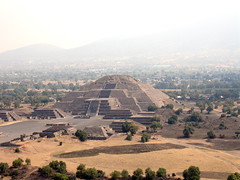AP world history chapter6 Flashcards
Terms : Hide Images [1]
| 11744563440 | Meroe | *center of the kush dynasty* from about 250 B.C. to A.D. 150; known for its*manufacture of iron weapons and tools.* |  | 0 |
| 11744563441 | Piye | *king of Kush around 750 B.C*., who gained control of Egypt, becoming *pharaoh* and *uniting Egypt and Kush* |  | 1 |
| 11744563442 | Axum | The *Christian state in Africa* that developed its own branch of Christianity, Coptic Christianity, because it was *cut off from other Christians due to a large Muslim presence in Africa.* |  | 2 |
| 11744563443 | Niger Valley Civilization | Distinctive *city-based civilization that flourished from about 300 B.C.E. to about 900 C.E.* in the floodplain of the middle Niger and that included major cities like Jenne-jeno; the Niger Valley civilization is particularly noteworthy for *its apparent lack of centralized state structures*, having been organized instead in *clusters of economically specialized settlements*. |  | 3 |
| 11744563444 | Maya civilization (300-900 CE) | Classical Mesoamerican civilization *located on the Yucatan Peninsula*, used slash and burn farming, *organized into city-states* |  | 4 |
| 11744563445 | Teotihuacan | *first major metropolis* in Mesoamerica, *collapsed around 800 CE*. It is most remembered for the gigantic "pyramid of the sun". |  | 5 |
| 11744563446 | Chavin | the *first major South American civilization*, which flourished in the *highlands of what is now Peru* from about* 900 to 200 B.C.* |  | 6 |
| 11744563447 | Moche | South American civilization which *rose to power following the collapse of the Chavin* in the Andes |  | 7 |
| 11744563448 | Wari and Tiwanaku | *Two states that flourished between 400 and 1000 C.E.* in the highlands of modern *Bolivia and Peru*. At their height they *possessed urban capitals* with populations in the tens of thousands and *productive agricultural systems.* |  | 8 |
| 11744563449 | Bantu expansion | *Gradual migration of Bantu-speaking peoples* from their homeland in what is now* southern Nigeria and the Cameroons into most of eastern and southern Africa*, a process that began around 3000 B.C.E. and continued for several millennia. The *agricultural techniques and ironworking technology* of Bantu-speaking farmers gave them an *advantage over the gathering and hunting peoples* they encountered. |  | 9 |
| 11744563450 | Chaco Phenomenon | Name given to a *major process of settlement and societal organization that occurred in the period 860-1130 C.E.* among the peoples of Chaco canyon, in what is now northwestern New Mexico; the *society formed is notable for its settlement in large pueblos and for the building of hundreds of miles of roads* (the purpose of which is not known). |  | 10 |
| 11744563451 | Mound Builders/Cahokia | 900-1250 C.E. *Cahokia was the capital of the surrounding territory* and held the *largest population in North America.* Cahokia was *known for their trade routes* and their connections with other civilizations, , Both Demonstrated how *large settlements emerged* after beginning to plant corn. Sharp class distinctions and high class. |  | 11 |
| 11744563452 | Pohnpei | *member of Federated States of Micronesia*; tropical island in South Pacific Ocean |  | 12 |
| 11744563453 | Tonga | *"The Friendly Islands," is situated in the Tongan archipelago* in the southern Pacific Ocean, about a third of the way along a line running from New Zealand to Hawaii. It lies south of Samoa, east of Fiji, and just north of the Tropic of Capricorn. |  | 13 |
| 11744563454 | mana | *religious power or energy* that is concentrated in *individuals or objects* |  | 14 |
| 11744563455 | Tapu | Of *sacred status* |  | 15 |
| 11744563456 | Yap | traditionally refers to an *island located in the Caroline Islands* of the western Pacific Ocean, a part of the Federated States of Micronesia.*They are formed from an uplift of the Philippine Sea* Plate, and are referred to as "high" islands as opposed to atolls. |  | 16 |
